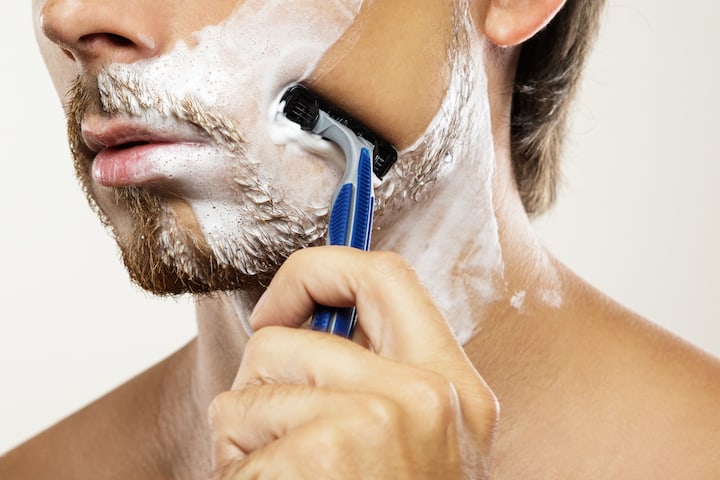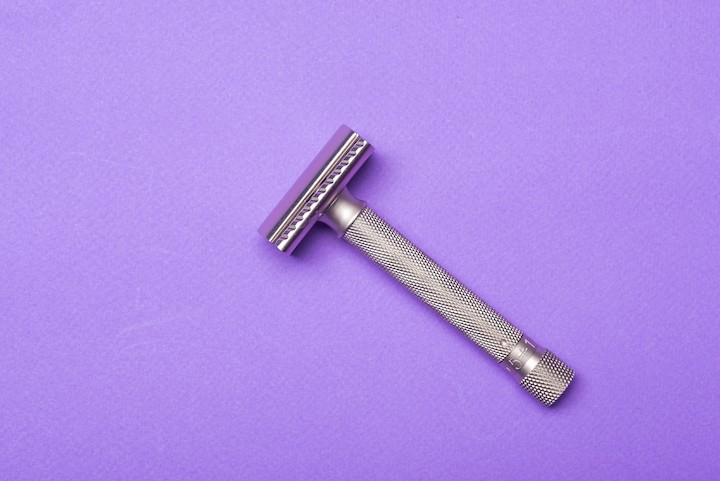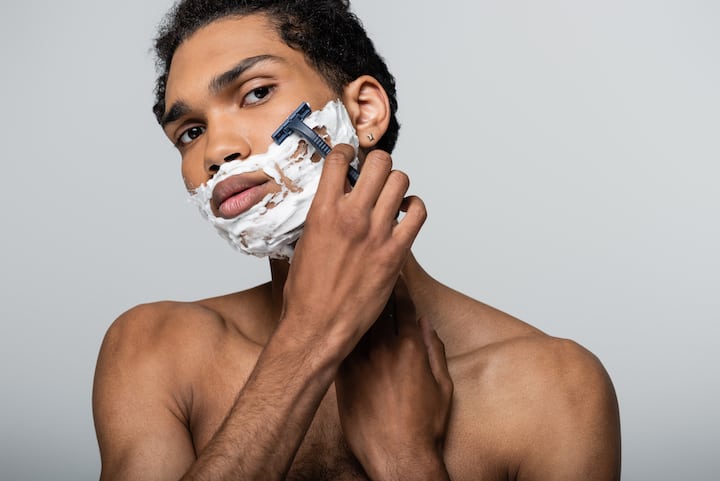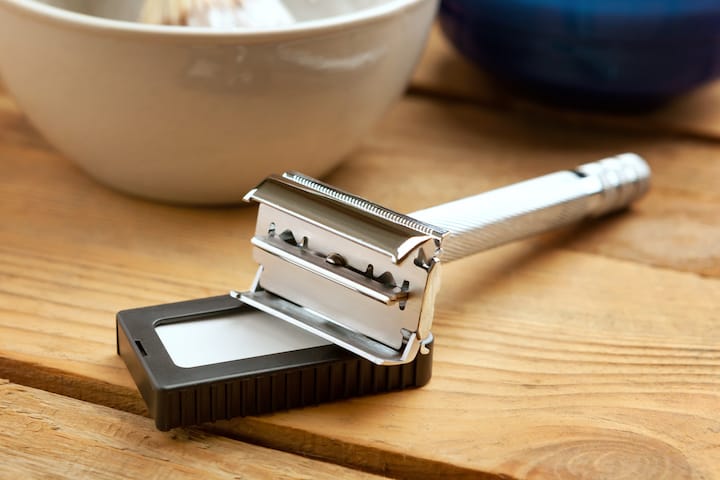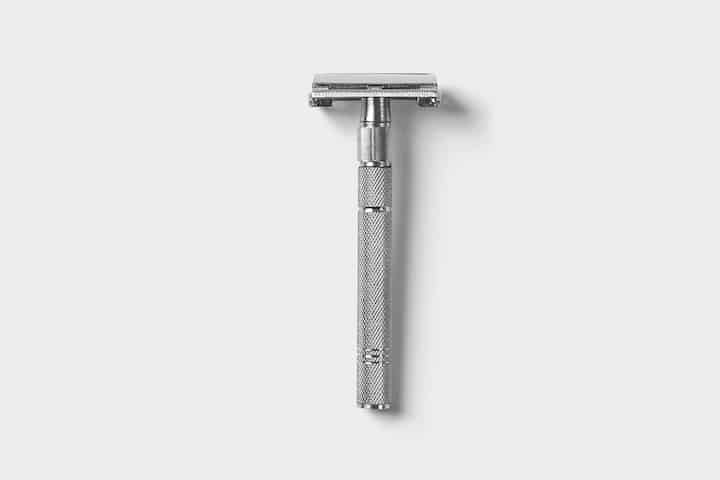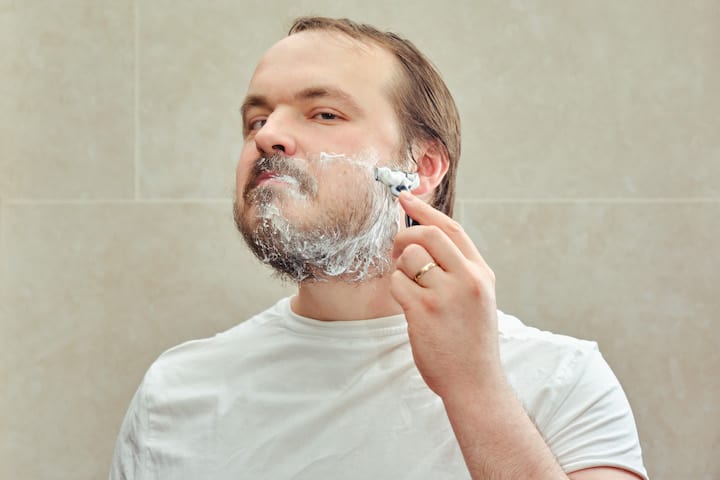Expensive cartridges, razor burns, cuts, nicks, and constant irritation. Sounds familiar? Shaving is never easy, especially when using the wrong shaving tool.
Luckily, shaving has come a long way and continues to improve as time goes by. Today, you have a whole array of shaving tools that you can choose from depending on your budget and personal preferences.
One of the best shaving tools on the market is the safety razor. Shaving, like everything else, has benefited from new and emerging technologies.
The old-school safety razor retains the authenticity of the first safety razor. As such, it appears a little intimidating, especially to those who are used to the newer high-tech, five-blade razors.
But ask anyone who has used a safety razor before. They will tell you that it was the best shave of their life.
So what makes this old-fashioned razor compete with newer models and, even most of the time, come up on top?
Read on to understand more about safety razors, their history, and how to master using one.
Table Of Contents
- What Is a Safety Razor
- Benefits of Using a Safety Razor
- How Do Safety Razors Work
- Short History of Safety Razors
- Pros and Cons of Using a Safety Razor
- Types of Safety Razors
- Parts of the Safety Razor
- How to Choose the Best Safety Razor
- Tools to Use With a Safety Razor
- How to Use a Safety Razor
- How to Maintain Your Safety Razor
- Safety Razor vs Disposable Cartridge Razor
- Does More Spending Mean More Quality
- Do’s And Don’ts With a Safety Razor
- FAQ About Safety Razors
- Is shaving with a safety razor better?
- What’s the difference between a normal razor and a safety razor?
- Why do they call it a safety razor?
- How do you not cut yourself with a safety razor?
- Why do safety razors have two sides?
- Can you shave pubes with a safety razor?
- Can you shave against the grain with a safety razor?
- Are safety razors also suitable for beginners?
- How often do you need to shave with a safety razor?
What Is a Safety Razor
Referred to as double edge razors or DE razors, safety razors became popular in the 20th century thanks to King Camp Gillette.
But what is a safety razor? It is a shaving tool that comes with a protective device that is positioned between the blade edge and where the razor comes into contact with the skin,
This positioning means less irritation and an injury-free shave every time you use one. Safety razors have revolutionized shaving in so many ways.
Before their invention, men were highly dependent on barbers to shave them, which was expensive.
After introducing the safety razor, men could shave at home as many times as they wanted without incurring the high barber fees.
It is known as the double edge razor because it has two edges that you can use to shave with. It uses small blades that you can change at home to improve your shaving experience.
Benefits of Using a Safety Razor
Offers the Best Shave
Shaving with a safety razor not only guarantees a close shave but a smooth one as well. The design of the razor helps prevent irritation.
It helps that the processes and tools for wet shaving have improved over the last century. When using a safety razor, for the smoothest of shaves, try shaving with shaving cream or soap.
Saves You Money
Unlike disposable razors, a safety razor is designed to be used for years, saving you lots of money.
The only things you need to replace are the blades. You can even pass down the razor to a relative when you are done.
No More Skin Issues
Multi-blade razors are designed to cut the hair below the skin surface. This leaves you prone to razor burns and ingrown hairs. The safety razor is a single-blade razor that cuts hair at the level of your skin.
After every shave, this means fewer razor bumps, redness, and ingrown hairs. Your skin needs that, especially if you shave a couple of times a week.
Good for the Environment
If you are keen on saving the planet, then there is no better way of doing that than opting for safety razors.
Every year, 2 billion cartridge razors are thrown away, adding up to the menace that is plastic waste already chocking the planet.
Safety razors can be reused over and over again, minimizing waste. They also bio-degrade more quickly than cartridge razors.
Part of a Tradition
Safety razors have been in existence since 1904. Your great-grandfather and grandfather probably shaved with a safety razor.
There is beauty when you can connect with great men who shave using safety razors. This is especially when safety razors are passed down from one generation to another in the family.
If you got your safety razor from your father, you could carry on the tradition by passing it down to your son.
How Do Safety Razors Work
Safety razors are easy to use. However, they take getting used to it. The technique of shaving with such a razor is different from how you would shave with a cartridge razor.
The two main things to keep in mind when shaving with a safety razor is;
- Maintain zero pressure when shaving
- Use the correct blade angle
The blade on a safety razor is exposed and touches the skin directly when shaving. The whole design ensures that the blade slices through your facial hair at an angle rather than dragging through the hair and scraping the blade across the skin.
This means that you only need the lightest of pressure so that rather than gliding across the skin surface, the blade barely touches the skin.
It also means holding the razor so that the blade touches the skin at an angle of 30°. This way, the blade sits parallel to the skin and not perpendicular.
The safety razor is designed so that the blade sits at a right angle to the handle. As such, you have to hold the handle perpendicularly to the skin so that the blade is at about 30° to the skin.
Short History of Safety Razors
The safety razor was first developed in 1904 by King Gillette. It was called the safety razor because it was much safer to shave with than other methods like the straight razor.
Gillette’s innovation played a huge role in the product’s success, after which he was awarded a contract to supply the razor to the American troops fighting in World War I.
Gillette’s safety razor began being included in the premium shaving kit for men that all troops received when they served in the war.
The returning soldiers kept their shaving kits, continuing the shaving tradition and creating a new tradition where men began shaving with safety razors.
This trend created a new market for double edge razor blades in America. Gillette’s safety razor soon became the world’s best double edge safety razor, with its popularity growing even overseas.
Before the safety razor existed, men had to deal with razors that needed stropping and honing now and then.
Because of that, men needed to go to the barber for a shave leaving the shaving tradition to the rich and elite in the society.
King Gillette’s safety razor forever changed grooming for men. The safety razor has undergone innovational changes but still maintains the same concept as the first razor.
Pros and Cons of Using a Safety Razor
Pros
- Close shave. A safety razor offers a smooth and close shave close to what the straight razor provides.
- Affordability. The safety razor is very affordable when buying and maintaining it—the razor averages between $20 and $50. Refilling the blades is a tenth of the cost of refilling a cartridge razor. In the end, the cost of owning a safety razor is less than that of holding a cartridge razor. On top of that, the blades of a safety razor last longer, and the quality is maintained for longer.
- Durable. A high-quality safety razor should last a lifetime as long as you maintain it well.
- Works well with all products. Whether you use expensive shave butter or cheap shaving cream, the safety razor works well with every product.
- Easy to clean, The safety razor is made so that the blade doesn’t clog even when you are shaving a full beard with very thick shaving cream. The space between the guard and the blade is sufficient to make rinsing between shaving easy. Should it get clogged, all you need to do is unscrew the head and wipe the blade and you are good to go.
- Versatility. The blades of a safety razor are universal and work with almost every safety razor on the market. This has contributed significantly to the affordability of the razors.
- Stylish. Safety razors are unique, stylish, and classic. Once you master the shave, you will have a hard time going back to cartridge razors.
Cons
- Nicks and cuts. Safety razors are fun to work with once you’ve mastered the shave. Before that, though, you are prone to cuts and nicks a few times.
- A slight learning curve. To be a master of shaving with a safety razor, you need both practice and patience. It won’t happen in a day and you will have a few minor accidents along the way, but you will get there eventually.
- Requires a lot of rinsing. This is not such a bad thing, though, since you need a clean razor for a smooth shave. A safety razor needs to be rinsed more times between shaves, but it rinses easily.
- Hard to travel with. Depending on how and where you are traveling, you may have difficulty traveling with your safety razor. To prevent that, always bring a backup cartridge razor with you.
Types of Safety Razors
Closed Comb
This is the most popular mount edge found on most safety razors. The closed comb plays a vital role in helping tighten the skin when you are shaving.
The closed comb is simply the guard found on some safety razors and provides a layer of protection between the blade and the skin surface.
A majority of double edge safety razors are close comb. They provide a mild shave and are ideal for wet shaving beginners.
Open Comb
Open comb safety razors have openings that increase blade exposure, providing a more aggressive shaving experience.
This means that such a razor shaves quickly and you don’t need to do multiple passes of the blade to get all the hair.
The only problem with such a razor is that you are more likely to cut yourself as such open comb safety razors are best suited for men already familiar with safety razor usage.
These razors are also suited for men who don’t frequently shave since they can cut even the longest and thickest hairs without the blade getting clogged.
Adjustable Safety Razor
These kinds of safety razors are designed so that you can change the space between the blade and the safety bar.
A larger blade gap means more aggression and may not be the best if you are a beginner.
Slant Bar Razor
The slant bar is found in a few safety razors. Instead of cutting the facial hair straight on, a slant bar razor tilts to cut the hair at an angle.
Slant bar razors are best suited for men who have experience using safety razors and those who have sensitive skin since the cutting motion reduces pulling and tugging of the hair follicles.
Butterfly Razors
These are safety razors that open from the top so that you can insert the blade rather than unscrewing the whole head.
Such razors are ideal for anyone who is not comfortable handling a blade or wants a classic-looking razor.
Parts of the Safety Razor
Razor Head or Cap
The razor head is the top part of a safety razor. The head holds the blade in place. The top cap is the top part of the razor head and covers the blade so that it’s not exposed when shaving.
The blade is set between the razor head and the cap and when screwed together, the razor should be ready to cut.
Mount
Cartridge razors have a pivoting head that allows the blades to remain in contact with the skin when shaving. The blade in a safety razor is set between the razor head and the mount.
The head of a safety razor doesn’t pivot or move. As such, you need to hold the razor at an angle when you are shaving.
Handle
The handle of a safety razor holds the head, the cap, and the blade. Handles vary in length, grip, and weight from one brand to another.
Shorter handles allow for better grip and control when shaving, especially if your hands are coated with shaving cream.
On the other hand, Longer handles work best for men who have larger hands. Safety razors tend to be heavier than cartridge razors when it comes to weight.
This added weight is good since you don’t need to put a lot of pressure on the razor when you are shaving. The grip determines how easy of a shaving experience you will have.
How to Choose the Best Safety Razor
Aggressiveness of the Razor
One of the most important factors to consider in a safety razor is its aggressiveness, especially for beginners.
An aggressive safety razor has a more exposed blade due to the shape of the razor head. The more aggressive the razor is, the quicker the shave will be.
An aggressive razor also means a higher risk of cutting yourself. If you’ve never used a safety razor in the past, go for a mild one.
If you are a wet shaving pro and have been using safety razors for years, an aggressive razor makes more sense. An aggressive razor means less irritation since you don’t need to make a lot of passes to remove all the hair.
If you don’t want to go back to the shop for another razor after you’ve mastered the shave, an adjustable safety razor makes sense.
Usage of an adjustable safety razor has been on the rise for years among men familiar with wet shaving and safety razors.
Weight
The weight of a razor plays an important role when you are shaving. A heavier safety razor provides for a steadier hand when you are shaving.
You are likely to feel safer, especially if you are just getting started with safety razors when you use a heavy one.
This is because the razor’s weight does all the work for you and you don’t need to apply more pressure than required for a clean shave.
Handle Length
Safety razors come with either 80mm or 100mm in length handles. The length determines the quality of your shave.
It all comes down to comfort. Choosing one over the other will depend on your personal preference and how the razor feels in your hands.
Handle Texture
The handle texture determines the grip quality. Shaving your chest is easy when you are using textured handles since they provide a better grip, especially if you will be using shaving oil.
Cap Shape
The cap shape determines the quality of your shave. When buying a safety razor, go for one with a slim head.
The slim head plays a vital role in helping you reach tricky spots like under the nose. The cap curve also determines just how aggressive the razor will be.
A safety razor with a larger curve means that the blade turns at an angle, providing a milder shave that is great for a beginner.
Head Type
Safety razors come in six different head types. These are determined mainly by the shape of the safety bar. The type of head determines just how aggressive or mild a razor is.
A straight bar head is flat and straight. Such razors are the mildest since there is very little blade exposure. Such a razor also catches less on the hair, thus requiring more passes when shaving.
Scalloped razors have razor heads with a beveled bar surface. They are the most common and work well for men with sensitive skin. The blade is slightly exposed, which means fewer passes as you are shaving and thus less irritation.
Closed comb razors have a safety bar that guards the blade and comb that directs that hair into the razor. They are ideal for beginners and those who have coarse hair.
Open comb safety razors don’t have a safety bar and as such, the blade is more exposed. These razors are the most aggressive and should therefore be used by men who are already experienced in using safety razors and those who don’t shave frequently.
Slant head safety razors have a slanted safety bar. The design makes shaving more efficient since they shave at an angle.
Razor Type
Safety razors either have a fixed blade exposure gap or a standard straight comb. However, adjustable razors still exist if you want a razor that helps you control how much blade is exposed.
Adjustable safety razors are great if you shave different body parts with varying hair thickness.
Tools to Use With a Safety Razor
So your shaving kit already has a Wilkinson sword razor for a shave without irritation. But do you have the tools to accompany that? Here are a few things that you can’t do without if you have a safety razor.
Shaving Cream or Soap
No shaving kit is complete without shaving cream or soap. Shaving soap and cream make a difference when shaving.
A quality shaving soap or cream helps soften your whiskers before shaving. Using shaving soap or cream also makes shaving easy, especially if you are using a very aggressive safety razor.
Shaving cream or soap also means smooth skin on your face, thanks to the moisturizer in such products.
Shaving Brush
If you prefer shaving soap, then a shaving brush is a must-have in your shaving kit. There are different shaving brushes on the market, but badger hair brushes are the best.
Some shaving brushes are made of boar’s hair or horsehair and are less expensive if you are on a budget. However, such brushes are of lower quality and will require replacing after a few months.
Aftershave Balm or Lotion
Aftershave care is critical after all the abuse your skin goes through when shaving.
There are so many great aftershave lotions and balms that you can choose from. Aftershave lotions and balm helps soothe the skin and reduce the redness associated with shaving. A good aftershave lotion also helps prevent razor bumps and ingrown hairs.
Alum Block
Alum occurs naturally and has antiseptic effects. An alum block helps close the pores and mend the microscopic nicks and cuts you may get when shaving.
An alum block is a must-have for those getting started with wet shaving and double edge razors.
How to Use a Safety Razor
Step 1 – Clean your face
Like when shaving with a cartridge razor, the first thing you need to do is clean your face with warm water. Warm water helps open the pores and softens your facial hair so that the razor glides smoothly on the surface.
Step 2 – Apply pre-shave oil
Pre-shave oil is a great product to have in your shaving kit since it creates a smooth surface that helps prevent razor tugging and pulling when shaving.
Step 3 – Apply shaving cream or soap
Soak your shaving brush in warm water for a while and then swirl it on your shaving soap or cream. After that, swirl it in a shaving bowl with little water to create lather.
Once you have enough lather, apply it to your face with the shaving brush to cover all the hairs.
Step 4 – Start shaving
Hold your safety razor at a 30-degree angle and begin shaving. Shave in short strokes, applying as little pressure as possible.
If you have wrinkles or loose skin, hold the skin taut to create a smoother surface for shaving. You can also puff your cheeks for a smoother and close shave.
Step 5 – Apply aftershave
Rinse your face with cold water. Cold water soothes the skin and closes the pores. After that, apply aftershave lotion or oil.
How to Maintain Your Safety Razor
Step 1 – Cleaning
Always clean the razor after use to remove hair and gunk that may be clogged in the head. For deeper cleaning, disassemble the safety razor by twisting the handle, opening the head, and removing the razor.
Soak the parts in warm water and add a little mild soap. This helps remove any debris without damaging the razor’s finish.
You can also soak the parts in warm water with vinegar but make sure you don’t use too much vinegar as this can corrode the stainless steel finish.
Clean with a soft rag to remove any build-up debris and rust, ensuring you get even between the tight corners. You can use a soft-bristle brush or cotton swaps for this step.
After that, you can disinfect the razor by dipping and rinsing it in 100ml of isopropyl alcohol. Follow that up with a scrub in warm soapy water.
Step 2 – Storage
Always dry the razor after use to remove any water damage to the steel finish. Avoid leaving your razor on the bathroom sink when it comes to storage since it will be exposed to too much humidity.
Instead, store the razor in a cool and dry spot like a bathroom cabinet. It might also go a long way if you invested in a razor stand to keep your razor away from moisture.
Safety Razor vs Disposable Cartridge Razor
There is a high chance of shaving with a cartridge razor right now. Cartridge razors are more common and easy to use and there is barely any learning curve to master the shave.
Cartridge razors are typically disposable razors that come with replaceable multi-blade heads. They are usually made of a combination of cheap plastic and metal or just plastic.
The cartridge razor became popular in the 1960s and 1970s, leading to a decline in safety razors.
When you compare the two razors, the safety razor comes up on top in so many ways. For one, the safety razor is more durable.
The T-shaped razor features a double-sided razor head. It is elegant and classic and can be intimidating at first.
Both the safety razor and cartridge razor require maintenance. The only difference is that rather than replacing the entire head, the only thing that needs replacing on a safety razor is the blade.
As a result, safety razors are a better greener option due to the low-waste shaving option. The handle, when maintained well, should last a lifetime while the blades can easily be recycled.
The safety razor does a better job than a cartridge razor when it comes to shaving. Thanks to its design, the safety razor provides a close and smooth shave free of irritation. Most men who’ve switched to safety razors rarely go back to cartridge razors.
Does More Spending Mean More Quality
Like many products, you will always wonder if spending more guarantees you more quality. In some sense, it does when it comes to safety razors.
Safety razors are affordable in the first place. The overly cheap ones, however, are not made to last. Since a safety razor handle can last a lifetime, why not spend on a quality one, even if it means going outside your budget a little.
Safety razors are cheap to maintain since all you need is to replace the blades. In this case, spending more makes more sense since you will only spend that amount once.
Do’s And Don’ts With a Safety Razor
Do’s
- When you are shaving with a safety razor, let the razor’s weight do all the work for you. Avoid applying too much pressure as this can lead to cuts and lots of irritation in the end.
- When you are shaving, maintain a good angle. A 30-degree angle is more ideal when using a safety razor.
- Keep the skin taut, especially if you have loose skin and wrinkles. This ensures that the razor blade comes into contact with all the hairs for a close shave with minimal irritation.
- Shave using the triple-pass technique. Shave with the grain at first, then across and finish off shaving against the grain for less irritation and close shave.
- Always use pre-shave products, shaving cream, and soap plus post-shave oil or lotion.
Don’ts
- Don’t leave your razor sitting in the shower to prevent rust.
- Make sure you dry the razor entirely after each use and store it in a cool and dry place away from moisture.
FAQ About Safety Razors
Is shaving with a safety razor better?
Shaving with a safety razor is better than shaving with a cartridge razor. For one, safety razors don’t require you to replace the entire razor head. However, the biggest advantage is that safety razors guarantee a close and smooth shave free of razor bumps, irritation, and ingrown hairs.
What’s the difference between a normal razor and a safety razor?
The main difference between a safety razor and a normal razor, in this case, a cartridge razor, is the blade. Safety razors come with removable blades that attach to the razor head. You don’t need to remove the whole razor head. Compared to a straight razor, a safety razor doesn’t require blade sharpening and stropping.
Why do they call it a safety razor?
Safety razors first appeared in 1904, when men used to shave with the more terrifying straight razors that looked more like street weapons than razors. Due to the design of the razors, they started being referred to as safety razors.
How do you not cut yourself with a safety razor?
If you haven’t mastered shaving with a straight razor, you might end up cutting yourself. To prevent that, you need to hold the razor at a 30-degree angle against your skin. Use very light pressure and short strokes when you are shaving. At the same time, make sure you use shaving cream or soap for a smooth shave.
Why do safety razors have two sides?
Safety razors are double-sided so that you can use both sides of the blade to shave. This extends the blade’s life and ensures that you use little time when you are shaving, thus minimizing irritation.
Can you shave pubes with a safety razor?
Yes, you can still use a safety razor to shave your pubes. However, make sure that you are experienced in using such razors since the skin in your genital region is more sensitive and more prone to cuts and nicks.
Can you shave against the grain with a safety razor?
Most shaving experts advise against shaving against the grain. However, with a safety razor, there is no harm shaving against the grain, especially when you are making the last pass.
Are safety razors also suitable for beginners?
Safety razors are great for beginners. There is a slight learning curve, but once you master the shave, it will be the best shaving experience of your life. However, if you are a beginner, opt for a mild safety razor until you gain more experience using such a razor.
How often do you need to shave with a safety razor?
You can shave every day with a safety razor. It all comes down to the razor quality. If your safety razor offers a quality shave every time, there is no harm in using it every day.
Conclusion
Male grooming has come a long way in terms of razors and products. The safety razor is a classic and traditional razor that will give you one of the best shaving experiences. Safety razors provide the kind of a close shave you only get when using straight razors. They are cheap to buy and maintain.
When using a safety razor, the only thing you need is to replace the blades rather than the whole head, making them great for the environment. They are double-sided, which means that you can shave using both sides. This prolongs the life of your blade while ensuring that you spend as little time as possible when shaving.
There are so many kinds of safety razors available on the market. The one you choose will depend on your skin type, type of hair, and how often you shave. It doesn’t matter if you are a beginner or an experienced shaver; a safety razor can work for everyone.
Michele Meesh Antunes is the lady of the Beardoholic writers team and a genius when it comes to hair and beard styles that suit any face shape. She’s been a barber for years now and, no matter your personal style, she knows exactly what beard, hairstyle and length suit you. She brings the women’s perspective on beards, beard care, haircuts and hairstyles and male grooming.

